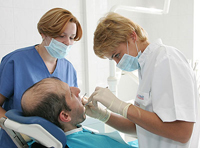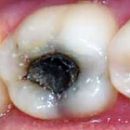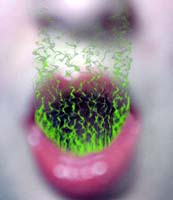What is perodontosis? Causes of the disease. Treatment and prevention of periodontal.
Content
What is perodontosis
Periodonts are a combination of arrogant fabrics, including a slope with a submucosal layer, bone fabric with periosteum and tooth binders. With the defeat of these tissues there is gingivitis or periodontitis, or periodontalosis.
The causes of the occurrence of periodontal diseases are quite a lot, but they can be grouped into local and general factors.
Local reasons are mainly:
- Incorrect bite, leading to inadequate loading of periodontal tissues, as well as to deterioration in the self-cleaning of the oral cavity;
- The fine run of the oral cavity, leading to the omitting of the gums, the exposure of the roots of the teeth and the destruction of the bone, which ultimately leads to the loss of teeth;
- Short bridles of the language and lips, which are powerful connecting tissues, pulling the gums of the mucous membrane;
- The presence of plaque and tartar containing a huge number of microbes.
What is important to know when detecting local factors for occurrence of periodontal diseases? They are initially traumatic, and with their timely and professional elimination, the likelihood of diseases seeks to zero.
The general factors of periodontal diseases include general, or somatic diseases, and the earliest defeats are usually determined in the organs and tissues of the oral cavity. Currently, more than 30 diseases are found, among which a number of a total of 100 percent. This is diabetes mellitus, urolithiasis, cardiovascular diseases, including hypertension and ischemic heart disease, ulcerative illness of the stomach and duodenum, hypo- and avitaminosis C, the defeat of the central nervous system, AIDS and T.D. The presence in patients with somatic pathology determining the weakening of the protective forces of the body creates favorable conditions for the negative impact on the periodontacts in the oral cavity microflora and other pathogenic factors.
Treatment of periodontosis
The purpose of the treatment of periodontal diseases in the presence of a somatic disease is to facilitate the symptoms, slow down the further progression of the process and prevent the development of complications. Ideally, an integrated approach to the diagnosis and treatment of periodontal diseases should be applied: it is periodontal assistance, and surgical operations, and orthopedic treatment, and if necessary - attraction of orthodontics. Only with general efforts it is possible to achieve a stable positive result in the treatment of such complex diseases such as periodontitis and periodontalosis.
 First of all, the connection of the disease with somatic pathology is determined (. E. common disease), in the presence of which the course of the diseases of the gums, as a rule, aggregate, and the treatment, respectively, is complicated. The gums are reflected in the reception of such medicines as aspirin, thrombbo ass, hormones, tranquilizers, neuroleptics and T. D. Patients taking these drugs must be regularly consulting with a periodontologist. The doctor, noticing the first signs of the side effects of drugs, prescribe preventive gum treatment than prevents the development of gingivitis and periodontitis. If there are only local factors that contribute to the development of gum disease, purely dental treatment is carried out. This is a correction of bite, deepening of the threshold of the mouth, lengthening of the bridles, removal of hanging edges seals, replacing the crowns with hanging edges, teeth shining...
First of all, the connection of the disease with somatic pathology is determined (. E. common disease), in the presence of which the course of the diseases of the gums, as a rule, aggregate, and the treatment, respectively, is complicated. The gums are reflected in the reception of such medicines as aspirin, thrombbo ass, hormones, tranquilizers, neuroleptics and T. D. Patients taking these drugs must be regularly consulting with a periodontologist. The doctor, noticing the first signs of the side effects of drugs, prescribe preventive gum treatment than prevents the development of gingivitis and periodontitis. If there are only local factors that contribute to the development of gum disease, purely dental treatment is carried out. This is a correction of bite, deepening of the threshold of the mouth, lengthening of the bridles, removal of hanging edges seals, replacing the crowns with hanging edges, teeth shining...
The correct bite is not only a beautiful smile. This is primarily a uniform distribution of chewing load on all the teeth, and through them - and perodont. In case of sorts of bite, part of the teeth is under the hyperload, as a result of which the Troof (meal) of the periodontal of these teeth is disturbed and local (local) periodontitis develops. On the other hand, when the teeth are crowded, the process of their natural self-cleaning is broken, the remains of food are stuck in separate areas, the flare accumulates, in which a huge number of microbes develop.
Surgical treatment - with short bridles of the language and lips, constantly pulling the gum edge of the cutters, and with the fine interest of the oral cavity. If there are evidence to these operations, it makes no sense only in the applications of drugs on gums, rinsing and injections. To achieve a good, stable result in the treatment of any disease, it is necessary to eliminate not only the symptoms of the disease, but also the reason for their occurrence. At different stages of the development of periodontitis with varying degrees of bone tissue destruction and atrophy of the gums on a par with therapeutic measures have to carry out patchwork operations. The meaning of these interventions is to remove the pathological tissue from the cream-gantry pockets. This fabric contains many microbes that produce acids that destroy bone tissue. Instead of healthy ligaments and alveolar bones, a loose granulation tissue is formed, increasing in the amount and replacing periodontal. Naturally, this tissue does not perform periodontal functions (tissue supporting teeth in wells), and destroys it, leading to the mobility of the teeth.
It should be noted that any treatment of gum diseases, as well as their prevention, begins with the removal of the dental stone and removal of the plaque, mechanically traumating the gums of periodontal and containing a huge number of microbes, by the way, the presence of which is caused by an unpleasant smell of mouth with gingivitis and periodontitis.









